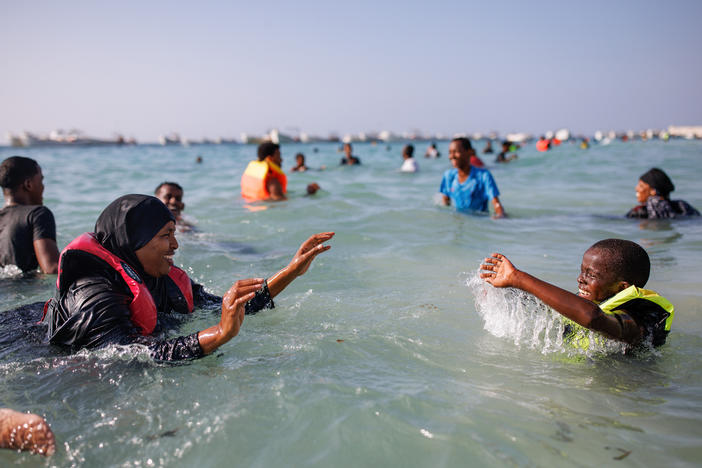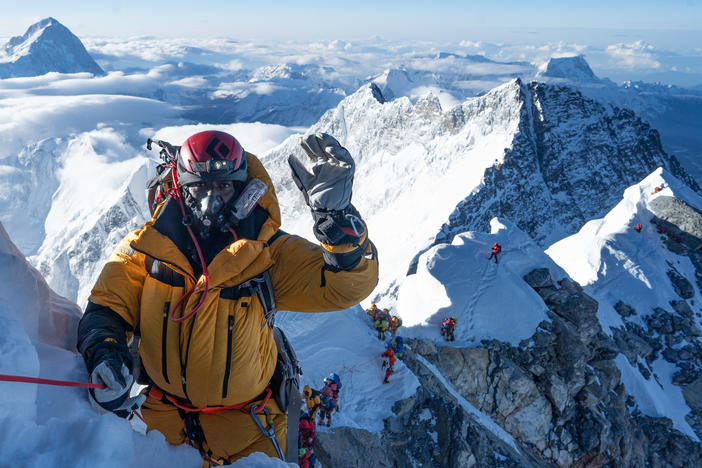Section Branding
Header Content
Meet the cool 62-year-old Kenyan on first all-Black team to summit Everest
Primary Content
When James "KG" Kagambi was 23, he climbed Mount Kenya in his homeland, the second tallest peak in Africa — and swore he'd never do it again. "I hated it," he recalls. "By the time I got to 15,000 feet, I had headaches." But then he encountered a magical substance for the first time. "I just loved snow. I touched it and knew that I like this. I was looking back [at the summit] and saying, 'You know what? I want to go back there right now.' After that, I couldn't stop."
He soon left his job as a geography, music, and physical education teacher of grades 5 through 8. And for 39 years, Kagambi has climbed the peaks of the world. He's summited Mount Kilimanjaro in Tanzania "so many zillion times," Denali twice, and Aconcagua (the highest peak in the Americas), among others. He's taught mountaineering from Patagonia to the Rockies, and he's trained climbers and guides the world over. Then, in 2020, he was invited to join the first all-Black climbing team to summit Mount Everest.
This Monday, Kagambi, now 62, will land at the Nairobi airport, returning home a national hero. On May 12, he became the first Kenyan to summit the tallest peak in the world – one of six climbers on the Full Circle Everest Expedition to reach the top of the 5.5-mile-high mountain.
This interview has been edited for clarity and length.
How did you come to find yourself a member of Full Circle — the first all-Black team of mountaineers to summit Everest?
At first, in 2020, when I was asked to come on this expedition, I actually said no.
Why?
The first thing obviously was my age — 60 at the time. Second was my knees. Last year, in the U.S., I saw a doctor and they said, "Do not even step. You need to do knee replacements."
So what made you decide to say yes?
Phil Henderson, the expedition leader, knows me very well. And he said, "I know when you are determined, you can do it. Even if you go there and you don't summit, you'll still be so resourceful to the group — being the oldest and having spent so much more time in the mountains than anybody else. People will respect what you say." Phil knew my abilities. I'm a good mountaineer, I make good decisions. He said, "If somebody deserves being here, being with us, it's KG." After that, for me, it was as simple as saying, "Oh yeah, I've been waiting for this. I deserve it. I'll just go do it."
How did you navigate the south route of Mt. Everest?
Most of us had already met on a team-building hike in January at the base of Everest. So we knew one another when we came to Nepal in April. The hike to base camp was obviously the easier part whereby it's quite scenic. There are motels along the way. You don't even need a sleeping bag. You get to a small village, you sleep there, you get your food there.
We spent a few days at Everest Base Camp (EBC), which is where I started to feel like I was in the wilderness. We practiced with ladders, which was good because between Camp EBC and Camp 1, and also Camp 1 and Camp 2, there are quite a number of places where you use ladders.
At EBC, around 17,400 feet, you want to spend enough time for your body to get used to the altitude. And after a few days, you start feeling like your body's going back to normal.
Then we did rounds of acclimatizing, called rotations, taking your body higher where there is less oxygen, and then coming back down again. Then it was time again to sit and wait for the weather. Fortunately for us, there was an opening for good weather. From Camp 3, we went to Camp 4. Then we staggered ourselves to go up to the summit.
You don't want to go too slow because if you do, you get so cold and exposed. You don't want to run because then you get out of breath and that affects your heart and your body. So the best thing is to use your own pace.
Some of our teams were very strong. One person summited around 3 a.m. and another by 4. I personally summited at 6.
And then, after you summit, you start heading down slowly back down to Camp 4. When I got to Camp 4, I was like, "You know what — why am I rushing? I will just stay here." The following day, we hiked slowly to Camp 2. And then, when I go to Camp 2, I realized I could go all the way to EBC. It took a long time. It was tiring but I got there by around 10:00 at night.
Did you take any selfies at the summit?
One of the most disappointing times was the summit, getting there and finding the whole place occupied by people. You could not even get time by yourself on the summit to take a photo.
It was crowded up there?
It was definitely crowded, yeah.
What does it mean to be part of this first all-Black team to summit Everest?
It is important to me. It's not the first time I've been with all-Black team. I did that on Denali. Still, it's important because it's part of history. This is the first time this has happened since they started climbing Everest. We wanted to show the world that people of color can do something like this. That is a good accomplishment. And also as part of making history for Kenya. As the first Kenyan, I'm proud of it.
But it's not only Black people. You're talking about people of color, you're talking about diversity. We have seen that in the outdoors, there's less people who come from different disadvantaged areas — age, gender, color, etc. It is important for me to bring all those people together.
How do we achieve that?
Part of it is being able to have the facilities to be able to take you to Everest, including economic. Also, it's unfortunate that all over the world, there's a lot of people who don't do things not because they can't but just because they are not exposed to it. In your community, nobody does it. People lack a role model. Nobody has come back and said, "Oh, I've been on the mountain." And I think when we do something like this, there are people who will look at us and follow suit. They don't have to be a mountaineer like me but we can introduce them into the outdoors. And to me that means a lot.
Tell me about your work over the years.
I stopped being a classroom teacher a long time ago when I joined NOLS (National Outdoor Leadership School based in Lander, Wyoming). And they gave me contracts all over the world. I've worked in Chile, I've worked in India, I've worked in North America. They trust me so much that whenever they have new rangers, they'll ask me to go and train them on first aid.
Currently, every summer I go out in the Rockies and teach kids mountaineering. At the end of one month of them being in the outdoors, I can see their growth. You can see that kid who is 14, 15, 16 years old... within a month, you can almost judge and say, "Wow, this kid has developed from here to here." That's the reward. For young people especially, three months in a classroom is not much. But one month in the outdoors teaches people so much — self-care, making decisions, learning about the environment.
I also have my own guiding company. Some of my clients are people who may want to go to a certain mountain but then think, "Oh, I'm too old to get there." Others tell them, "KG will get you there." I have the patience.
What do you think makes you a good mountaineer?
This is not an easy job. But I like the physical challenge of it. I like the fact that every day comes with its own challenges, and you learn so much by trying to solve all those problems. I like being with new people and meeting new people — the student you had yesterday is not the one you have today. I think that's what keeps me there.
What's mountaineering like in Kenya? Is there an active outdoor culture?
I've gone to the government to ask for help. And I've been told, "Oh, mountaineering is not recognized as a sport so we cannot help." And that's one of the points I want to put across to the government of Kenya — that it is time they need to recognize the importance of mountaineering as a sport. And not just mountaineering, but outdoor education — making sure that people going to school are also being exposed to the natural world.
What's next after Everest? A good book? Chocolate cake?
With Everest, I've done the four summits of the world. So maybe I could have a goal of doing the seven summits. That's just a thought. Fortunately, the three mountains that are left are not that challenging.
As for right now, I'm feeling good. A bit tired. My knees are uncomfortable a little bit, but I'll get through that.
What's the reaction in Kenya to your accomplishment?
Right after summiting, everything just went crazy. The president wants to meet me. I cannot even think of how it will be when I arrive. I'm not looking forward to that because I don't like being overrun by so many people. But I know it's so important to Kenya. And I expect — I not only expect, I know — that there'll be a lot of people at the airport waiting for me.
Copyright 2022 NPR. To see more, visit https://www.npr.org.
Bottom Content





